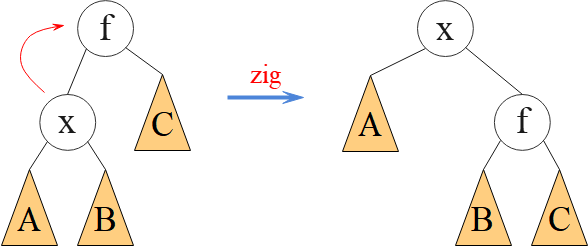【题目来源】
https://www.luogu.com.cn/problem/P3391
【题目描述】
您需要写一种数据结构(可参考题目标题),来维护一个有序数列。 其中需要提供以下操作:翻转一个区间,例如原有序序列是 5 4 3 2 1,翻转区间是 [2,4] 的话,结果是 5 2 3 4 1。
【输入格式】
第一行两个正整数 n,m,表示序列长度与操作个数。序列中第 i 项初始为 i。 接下来 m 行,每行两个正整数 l,r,表示翻转的区间。 输出格式 输出一行 n 个正整数,表示原始序列经过 m 次变换后的结果。
【输出格式】
输出一行 n 个正整数,表示原始序列经过 m 次变换后的结果。
【输入样例】
5 3
1 3
1 3
1 4
【输出样例】
4 3 2 1 5
【数据范围】
对于 100% 的数据,1≤n,m≤100000,1≤l≤r≤n。
【算法分析】
Splay 树简介:https://blog.csdn.net/hnjzsyjyj/article/details/138504578
● Treap 树解决平衡的办法是给每个结点加上一个随机的优先级,实现概率上的平衡。Splay 树直接用旋转调整树的形态,通过旋转改善树的平衡性。计算量小,效果好。
● Splay 树的旋转主要分为“单旋”和“双旋”。
所谓“单旋”,即把结点 x 与它的父结点交换位置,使结点 x 上升一层。“单旋”不会减少树的层数,对改善平衡性没有帮助。根据旋转方向,“单旋”又分为左旋(zag)与右旋(zig)。
所谓“双旋”,即两次“单旋”。“双旋”同时旋转结点 x,父结点 f 及祖父结点 g 等3个结点,能改善平衡性。“双旋”又分为“一字旋”与“之字旋”。
● Splay 树的旋转示意图




● Splay 树的基本操作是把结点旋转到树的根部,这样下次访问它时,只需查一次就 OK 了。
● Splay 树是动态树(LCT,Link Cut Tree)与树链剖分的基础。
● Splay 树曾经是最常使用的 BST。不过,现在经常使用 FHQ Treap 树实现很多传统的 Splay 树的题目。因为,FHQ Treap 树代码更容易写,效率也很高,且可做持久化。
【算法代码】
下面代码是 Splay 树的模板代码,但其中包含了本题(洛谷 P3391)未用的函数。例如:
本例使用了 pushup()、pushdown()、rotate()、splay()、insert()、get_val_by_pri() 、output() 等7个函数;未使用 find()、get_pre()、get_suc()、remove()、get_pri_by_val() 等5个函数。
#include <bits/stdc++.h>
using namespace std;const int maxn=1e5+5;
int n,m;
int root,idx;struct Node {int s[2],v,p; //subtree,val,rootint size,cnt;int lazy;
} tr[maxn];void pushup(int x) {tr[x].size=tr[tr[x].s[0]].size+tr[tr[x].s[1]].size+tr[x].cnt;
}void pushdown(int x) {if(tr[x].lazy) {swap(tr[x].s[0],tr[x].s[1]);tr[tr[x].s[0]].lazy^=1;tr[tr[x].s[1]].lazy^=1;tr[x].lazy=0;}
}void rotate(int x) {int y=tr[x].p;int z=tr[y].p;int k=(tr[y].s[1]==x);tr[z].s[tr[z].s[1]==y]=x, tr[x].p=z;tr[y].s[k]=tr[x].s[k^1], tr[tr[x].s[k^1]].p=y;tr[x].s[k^1]=y, tr[y].p=x;pushup(y), pushup(x);
}void splay(int x,int k) {while(tr[x].p!=k) {int y=tr[x].p;int z=tr[y].p;if(z!=k) {if((tr[y].s[0]==x)^(tr[z].s[0]==y)) rotate(x);else rotate(y);}rotate(x);}if(!k) root=x;
}void insert(int x) {int u=root, p=0;while(u && tr[u].v!=x) {p=u;u=tr[u].s[x>tr[u].v];}if(u) tr[u].cnt++;else {u=++idx;if(p) tr[p].s[x>tr[p].v]=u;tr[u].p=p, tr[u].v=x, tr[u].size=1;tr[u].cnt=1;}splay(u,0);
}void find(int x) {int u=root;while(tr[u].s[x>tr[u].v] && tr[u].v!=x) u=tr[u].s[x>tr[u].v];splay(u,0);
}int get_pre(int x) {find(x);if(tr[root].v<x) return root;int u=tr[root].s[0];while(tr[u].s[1]) u=tr[u].s[1];splay(u,0);return u;
}int get_suc(int x) {find(x);if(tr[root].v>x) return root;int u=tr[root].s[1];while(tr[u].s[0]) u=tr[u].s[0];splay(u,0);return u;
}void remove(int x) {int pre=get_pre(x), suc=get_suc(x);splay(pre,0), splay(suc,pre);int del=tr[suc].s[0];if(tr[del].cnt>1) tr[del].cnt--, splay(del,0);else tr[suc].s[0]=0, splay(suc,0);
}int get_pri_by_val(int x) {insert(x);int ans=tr[tr[root].s[0]].size;remove(x);return ans;
}int get_val_by_pri(int x) {int u=root;while(true) {pushdown(u);if(x<=tr[tr[u].s[0]].size) u=tr[u].s[0];else if(x==tr[tr[u].s[0]].size+1) return u;else x-=tr[tr[u].s[0]].size+1, u=tr[u].s[1];}return -1;
}void output(int x) {pushdown(x);if(tr[x].s[0]) output(tr[x].s[0]);if(1<=tr[x].v && tr[x].v<=n) printf("%d ",tr[x].v);if(tr[x].s[1]) output(tr[x].s[1]);
}int main() {scanf("%d %d",&n,&m);for(int i=0; i<=n+1; i++) insert(i);while(m--) {int le,ri;scanf("%d%d",&le,&ri);le=get_val_by_pri(le);ri=get_val_by_pri(ri+2);splay(le,0);splay(ri,le);tr[tr[ri].s[0]].lazy^=1;}output(root); //inorderreturn 0;
}/*
in:
5 3
1 3
1 3
1 4out:
4 3 2 1 5
*/
【参考文献】
https://blog.csdn.net/hnjzsyjyj/article/details/138504578
https://www.acwing.com/file_system/file/content/whole/index/content/6921304/
https://www.acwing.com/file_system/file/content/whole/index/content/6420964/


)
(7)抽象类和接口(上))


![[MySQL数据库] Java的JDBC编程(MySQL数据库基础操作完结)](http://pic.xiahunao.cn/[MySQL数据库] Java的JDBC编程(MySQL数据库基础操作完结))










)

